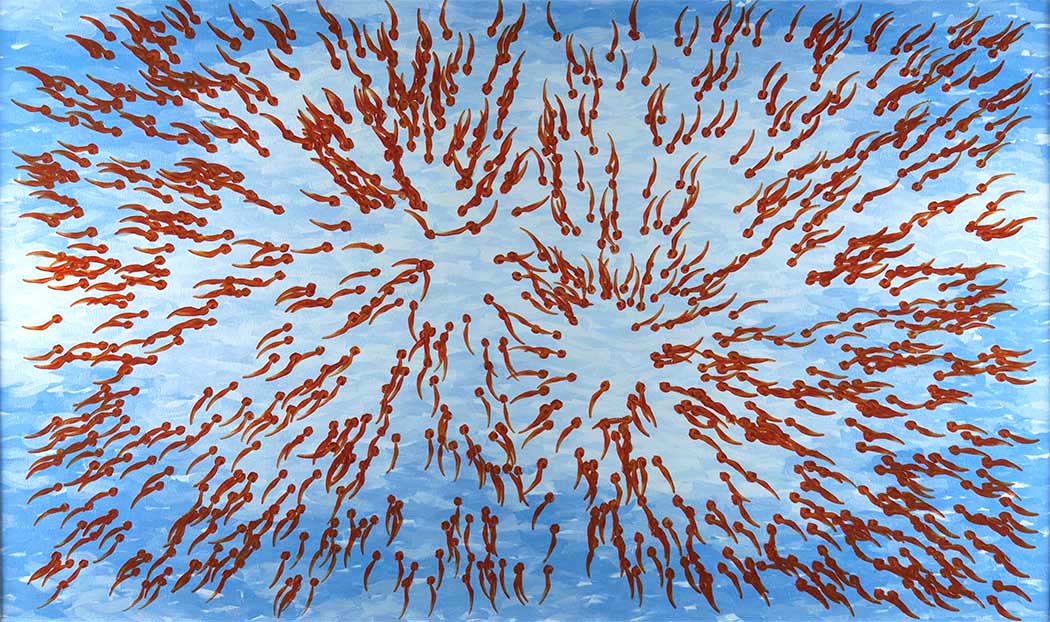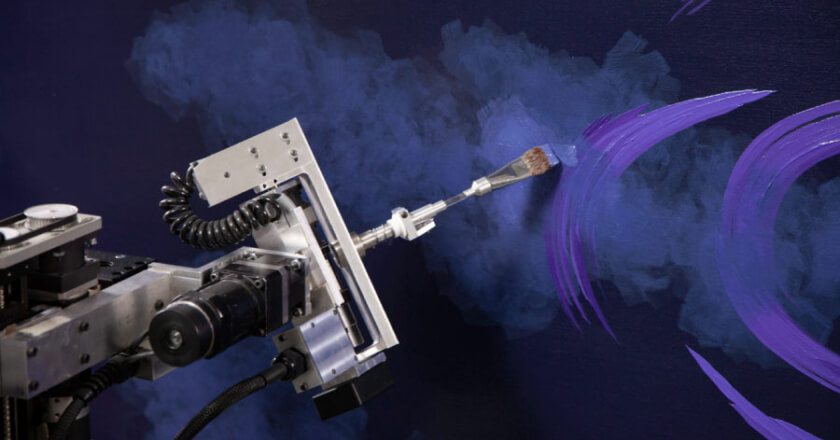Get Inspired
Build the life you love. Learn more about fusioneering:

Posted on February 20, 2022 in Fusioneering
Nearly a thousand little brushstroke amphibians. They are, technically, motionless – and yet, the frenzied movement of their swarm radiates energy that can be felt. This is the reality present in Paul Kirby and Dulcinea’s 48” x 78” painting, Tadpoles. The techniques used to create the piece extend beyond those traditionally found in painting: what’s at work here is a fascinating field that sits at the fusion of biology and computer science… a field that can potentially even help us realize “truer” artistic truths.
A flock of birds migrating south. Salmon moving upstream. A feeding frenzy. Larval amphibians learning to swim in a pond. These behaviors are not conscious processes; they are the actions of instinct. These examples are complex patterns and scripts of behaviors that exist innately within natural life – the biological equivalent of a computer code. If these organic functions can be replicated with real computer code, then what does that say about life as we currently know it? What questions about our existence can be answered by probing the depths of an entity’s biological “source code”? These thoughts form the basis of a field of study known as “artificial life” (not to be confused with the related and overlapping field of “artificial intelligence”). Artificial life scientists and researchers strive to examine, break-down, and reproduce complex systems “coded” into natural lifeforms in order to better understand the potential and limits of biological beings. It’s a fascinating field with incredible possibilities and promise – and that promise extends beyond scientific utilization.
Who among us has not found some hypnotic draw in the behaviors of a flock of geese passing overhead, in a school of fish moving as a single organism… in something as simple as ants swarming over food or tadpoles wiggling in a pond? A quiet meditation on the nature of life, spawned by observation… Paul and Dulcinea’s Tadpoles evokes the same feeling, and the piece shows the art that can be spawned from artificial life programs.
So, just how were artificial life systems employed to produce Tadpoles? To start, the titular tadpoles were created using swarming behavior theory. Swarming intelligence algorithms are a subset of AI. Generally speaking, the behavior rules for swarm agents (the objects doing the swarming) are actually quite simple: agents move at the same speed, the same approximate distance from each other, and work toward a similar heading.
Using these simple rules, Paul coded and brought 993 tadpoles to life with their designed objective to be swarming toward two positively-charged points in space. To create a more visually-pleasing and realistic distribution of tadpoles across the work, thirty-eight differently-sized, invisible spheres were placed around the swarm area, with these negatively-charged spheres designed to obstruct the tadpoles on their journey – making for a more compelling tapestry of movement in the finished piece. Through the power of modern computing, the tadpoles swam around the obstacles and toward the swarm’s goal position with the same rich complexity of actual, living animals. And so, Dulcinea’s brushstroke map for the vibrant foreground of the painting came to be.
Are any two birds truly alike? Are any two tadpoles? To achieve uniqueness in every tadpole true to nature, Dulcinea’s techniques and methods needed to evolve. Just as every great human painter grows and learns to fulfill the potential hidden within the next blank canvas, so too must Dulcinea develop and refine her skills. For Tadpoles, Dulcinea was given elaborate instructions to allow her to produce each tadpole in a single, complex stroke – and with enough variation to ensure that every tadpole felt special and one-of-a-kind.
For the painting’s background, Dulcinea utilized the “balayé” technique developed by the brilliant French post-Impressionist artist, Georges Pierre Seurat. “Balayer” is a French verb meaning “to sweep,” which is the general idea of the motion involved when using Seurat’s balayé method. The technique involves creating strokes with a flat brush, overlaid in a criss crossing pattern. The soft method of balayé creates visual depth and subtle energy that compliments and enriches the scene in Tadpoles without distracting from the urgent movement of the creatures over their brushstroke environment.
After the foreground and background designs were completed with their respective brushwork, what we’re left with is a group of inanimate, two-dimensional creatures moving over a painted background – and yet, at the same time, what we have is a visual meditation on the very concepts of life, nature, and the mind. The same hypnotic elements that draw our eyes and thoughts to biological swarms– be they birds, mammals, fish, frogs, or insects – pull on us and hypnotize us here, too. Nature has long made the very best in awe-inspiring, thought-provoking art, and the field of artificial life is only starting to crack the surface of how we can utilize and learn from all the power, complexity, and attraction of the natural world around us. Paul Kirby and Dulcinea seek to remind us that within all things there is a blueprint for beauty.
Looking for more inspiration? Head to the Gallery to see all of Dulcinea’s works to-date.
Are you interested in hearing the complete story of Paul and Dulcinea? Watch the video (nominated for Best Short Film at the 2021 Vail and Portland Film Festivals) for more info.
Want to be the first to know about every exciting new project at the Kirby Foundation?
Join Our Mailing ListBuild the life you love. Learn more about fusioneering:
Why pick which passion you should follow? Fusioneering allows you to cultivate many interests into something innovative and revolutionary.

Meet Paul and explore how blending your interests can empower you to follow your enthusiasm and bring your passions to life.